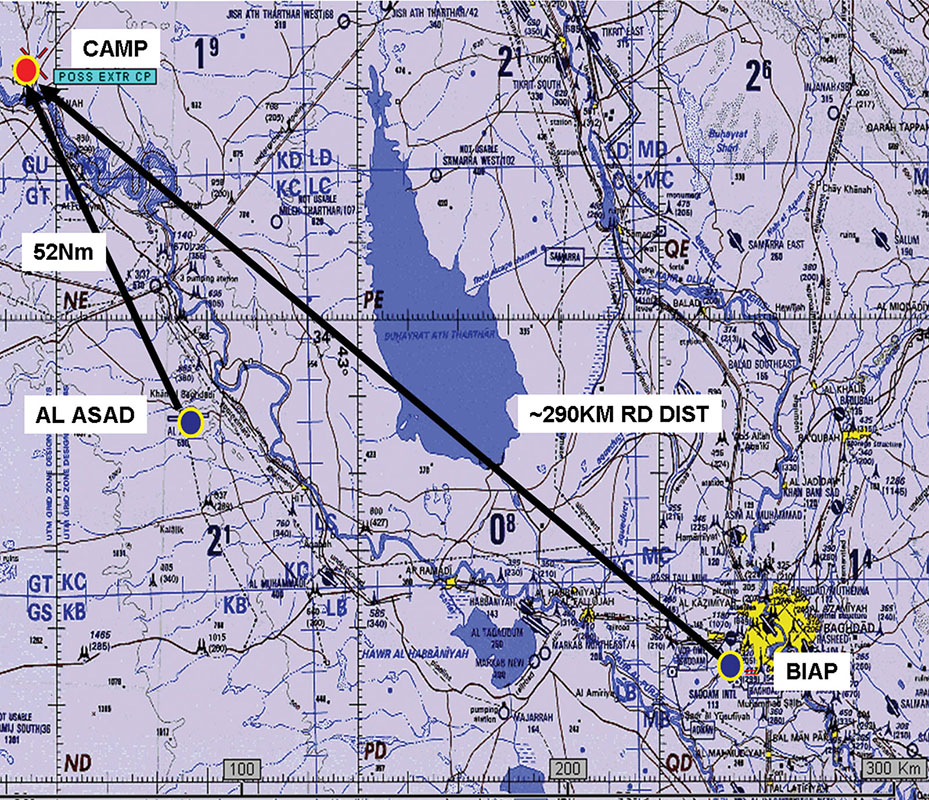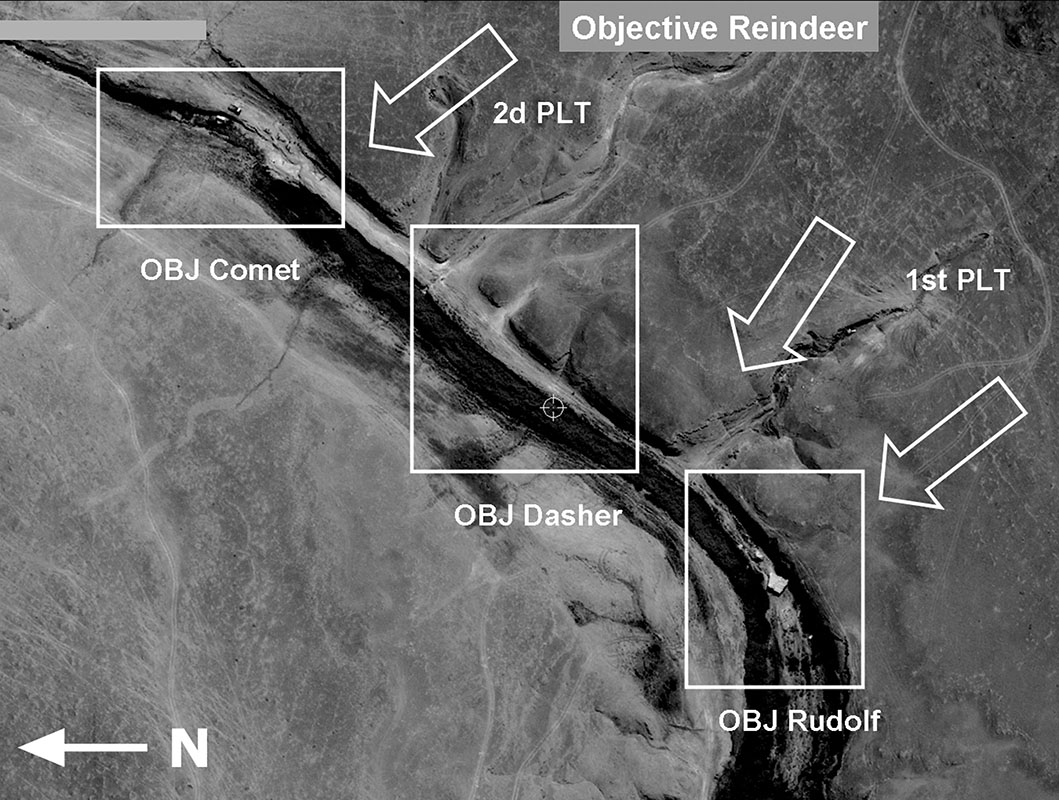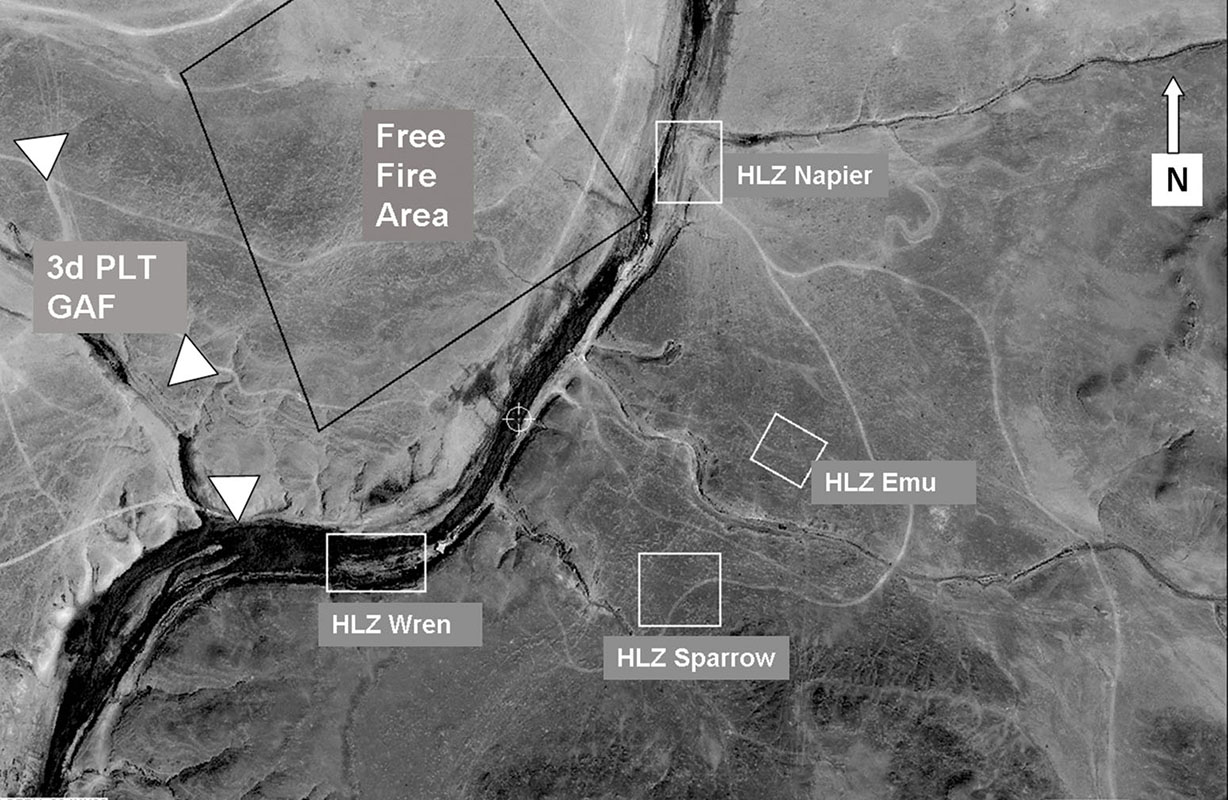On 27 July 2004 Vice President Richard B. Cheney stated that the terrorist threat did not represent a “foe we can reason with or negotiate with or appease. This is, to put it simply, an enemy that we must vanquish.”1
DOWNLOAD
On the evening of 11 June 2003, the Rangers from B Company, 2nd Battalion, 75th Ranger Regiment, attacked and killed over seventy Islamic terrorists at a training camp in the vicinity of Rawah, Iraq, thirty miles east of the Syrian border. During a coordinated assault on Objective Reindeer, two Ranger platoons and a company and battalion command element infiltrated via four MH-60K Black Hawks and two MH-47E Chinooks from the 160th Special Operations Aviation Regiment (SOAR), and attacked the camp from the east. A third platoon, with a battalion mortar team, traversed 175 miles overland and arrived simultaneously with the other two platoons, established blocking positions and a mortar position. Additional 160th SOAR assets, AH-6 attack helicopters, provided close air support during the operation. The Rangers’ orders were clear: Destroy all terrorists in the vicinity of the camp in order to prevent attacks against coalition forces—an excellent mission for Army Rangers.
The previous night at 2200 hours, Major (MAJ) John McGinnis (pseudonym), the operations officer and acting commander of Ranger elements in Iraq, and Captain (CPT) Mark Everett (pseudonym), assistant operations officer, received a warning order to begin planning for a combat mission against the terrorist camp. The 101st Airborne Division had been planning the operation for several days, but V Corps received new information that suggested that an attack from the terrorist camp was imminent. Even so, the Screaming Eagles needed several more days to execute the mission. Therefore, V Corps solicited a proposal from the 75th Ranger Regiment, which gave the mission to the 2nd Ranger Battalion. McGinnis and Everett, in conjunction with B Company commander CPT Hunter (pseudonym), developed a concept of the operation that same night. The collaborative planning process—including the company commander to develop the overall scheme—greatly shortened the amount of time that it took to complete troop leading procedures.2 Hunter devised a simple scheme of maneuver to ensure that no terrorists escaped, and that concentrated fires on the objective would achieve their purpose. Within several hours, McGinnis sent the plan back through command channels to V Corps, indicating that the Rangers could strike within twenty-four hours. Even so, McGinnis thought that the 101st would retain the mission.3
Objective Reindeer was a wadi, 500 feet long and 60 to 150 feet wide, with steep rocky sides 35 feet deep, and two smaller wadis channeling into the main creek bed. Reindeer actually consisted of three separate objectives: Dasher, Rudolf, and Comet. On 11 June at 0900, CPT Hunter issued the operations order to his platoon leaders: 1st platoon would insert via helicopters, then isolate and clear Objectives Dasher and Rudolf; next, 2nd platoon would insert by helicopters, isolate, and clear Objective Comet; 3rd platoon would simultaneously arrive overland in vehicles and establish blocking positions west of the objective to prevent any escapees. Minutes later, MAJ McGinnis informed Hunter that it looked like the mission would not take place; so, Hunter used the opportunity to run his platoon leaders through a planning exercise. By 1100, however, McGinnis informed him that the mission was to be executed that night, after all. Platoon leaders briefed their platoons, Hunter and his fire support officer finalized plans with the 160th SOAR planners, and the final air mission briefing and rehearsal drills were completed by 1700.4

The ground assault force (GAF) departed from Baghdad International Airport (BIAP) at 1545, negotiating several damaged bridges as it moved along Highway 12 running from Fallujah through Ar Ramadi and Hit to a junction south of Rawah. Along the way, the GAF linked up with two M3 Bradley platoons from the 3rd Armored Cavalry Regiment in the vicinity of Hadithah, and established a forward arming and refueling point (FARP) near the highway south of Rawah. After quickly refueling at the FARP, the GAF awaited the signal to begin movement to the objective: the commencement of preassault fires. At the signal, the GAF proceeded to the objective, while the Bradley platoons secured the FARP and stood ready to reinforce the GAF, if needed.
The helicopter assault force (HAF) departed BIAP and flew to Al Asad Airfield for refueling, arriving at 2030. After refueling, an MH-60K Black Hawk failed to start minutes before the scheduled departure time. The crewmembers escorted key leaders to another Black Hawk in accordance with the bump plan—a contingency plan to crossload key individuals or groups in the event of an aircraft breakdown—which left one Ranger squad at the airfield. The HAF departed two and a half minutes late, but arrived on time for H-hour: 2200. Sequencing into target, the first pair of AH-6 gunships suppressed surviving enemy fighters on Objective Dasher after six Joint Direct Attack Munitions (JDAMs) had exploded in an airburst over the site, and an AC-130 Specter Gunship had raked the area with munitions.
First Lieutenant (1LT) Peter Korenek (pseudonym) and his 1st Platoon Rangers peered out the open cargo doors of the lead MH-60K (“Kilo”) Black Hawk and saw fires burning in the vicinity of helicopter landing zone (HLZ) Sparrow. Once the Black Hawk touched down, the Rangers raced into the dusty darkness as a pair of AH-6 Little Bird gunships strafed an enemy position with minigun rounds and rockets. Enemy fighters shot wildly at the helicopters with rocket propelled grenades (RPGs), and one AH-6 sustained a hit to the nose bubble, but the rocket did not detonate.
Landing several hundred meters short of the HLZ because of a Little Bird gun run, Staff Sergeant (SSG) Mitchell Burn (pseudonym) oriented his squad toward Objective Dasher and ran across the pancake desert with Korenek. The squad reached the draw as an MH-47E (“Echo”) Chinook touched down with the remainder of 1st Platoon. South of Korenek’s position, a second Black Hawk landed at HLZ Wren. SSG Alan White (pseudonym) disembarked with his squad and seized the high ground near the gulch overwatching Objective Rudolf within ninety seconds.
Second Platoon inserted via a Kilo and an Echo into HLZs Napier and Emu, respectively. Sergeant (SGT) Roger Mueller (pseudonym) and his team disembarked the Chinook first, followed by the company command element, and oriented on Objective Comet. Mueller and the weapons squad established a blocking position and prepared to clear through Comet. Company First Sergeant (1SG) Philip Roemer (pseudonym) was the last off the Chinook. He, senior medic SGT Brad Gillis (pseudonym), and the radio operator, moved toward the smaller east-west wadi leading to Objective Dasher to establish a casualty collection point (CCP). As they moved, two terrorists fired on them from the prone position, shooting the radioman’s rucksack strap off his right shoulder. He and Gillian immediately shot and killed the fighters in the ditch near their CCP, registering the first kills in the fight. The remainder of 2nd Platoon moved from HLZ Napier into blocking positions, focusing on the wadi from the north and killing three fighters along the way with grenades and rifles.5

Meanwhile, the GAF arrived and successfully established blocking positions and a mortar position, but not without drama. One vehicle drove into a wash and had to be extracted. The mortar team switched vehicles were set up within ten minutes. The company executive officer, 1LT Nielson (pseudonym) radioed CPT Hunter with an update about 3rd Platoon’s situation, and then moved closer to Objective Reindeer, well protected by the higher ground on the western side of the wadi. All fires were oriented down into the wadi from both the east and west sides, reducing the potential for fratricide. Soon, the mortar team executed several fire missions in support of 1st Platoon along with the AH-6 Little Bird gunships.6
SSG Burn and his squad moved into the gulch on the platoon’s right flank, locating a large weapons cache of two thousand RPGs, fifty RPK machine guns, eighty-seven SA-7 surface-to-air-missiles, and countless other types of munitions. He marked the cache for destruction and pressed forward. The squad comprising the platoon’s main effort, led by SSG Roger Duncan (pseudonym), cleared the high ground south of Objective Dasher, killing five combatants, and then moved into the wadi. SSG Bradley Talbert (pseudonym) and his squad secured the platoon’s left flank, and engaged the enemy from the high ground overlooking Objective Rudolf.7

1LT Korenek and Sergeant First Class (SFC) Clint Anderson (pseudonym), the platoon sergeant for 2nd Platoon, coordinated their clearance into the wadi. SSG Duncan maneuvered his squad down the wadi and found twelve terrorists attempting to reorganize, and killed them all with direct fire. While maneuvering his platoon, Korenek received fire below the cliff, and dropped a fragmentation grenade in response. The grenade failed to stop the firing, so he climbed down the ledge to a point where he could get a clear shot on the enemy, killing them both. A burning vehicle in the center of the wadi prevented SSG Burn and his squad from providing adequate overwatch, so they continued to observe and fire at movement across the wadi to the west.8
As 2nd squad pushed south into the wadi, backlit by the burning truck, SGT Mark Walters (pseudonym), the lead team leader, spotted an RPG team and shouted, “RPG!” As he fired his M4 carbine, the enemy fired an RPG round that blew his leg off below the knee. In spite of his missing leg and shrapnel injuries to his left elbow, calf, and left thumb, Walters emptied a magazine into the grenade position, killing the gunner, all while shouting fire commands to his fellow Rangers. Platoon medic Specialist Gomez stabilized Walters, expertly treating his wounds under heavy fire. After Gomez stabilized and packaged Walters for travel, SFC Oscar Weimer (pseudonym) directed several Rangers to move Walters on a “Skedco” (Sked brand rescue sled) to HLZ Sparrow for evacuation. En route, they met 1SG Roemer and SGT Gillis also making their way to the HLZ. Weimer handed Walters’ equipment to the 1SG for accountability, and returned to the fight. Once Walters was prepared to move, the battalion tactical air controller called in the CASEVAC (casualty evacuation) helicopter that was air loitering nearby, allowing CPT Hunter to focus on the ongoing fight. The helicopter landed within thirty seconds, and Walters was passed into the care of the on board surgeon for the trip to Al Asad, where a medical airplane awaited.9
In spite of his missing leg and shrapnel injuries to his left elbow, calf, and left thumb, Walters emptied a magazine into the grenade position, killing the gunner, all while shouting fire commands to his fellow Rangers.
Meanwhile, SSG Duncan pinpointed another fleeing RPG gunner with his infrared laser, enabling his squad and SSG Bradley Talbert’s (pseudonym) squad to target and kill the gunner with their M240 machine guns. SSG Burn saw other enemy fighters run into the tall grass, and Korenek decided to clear the grass by fire with M240s and squad automatic weapons. The Rangers attempted to burn out the vegetation with incendiary grenades, flares, and burning debris, but the grass was too damp. At this point, their platoon declared their sector clear and the 1st Platoon Rangers began exploitation of the area.10
Second Platoon moved on line through Objective Comet, with SGT Mueller’s squad clearing the west side of the wadi, and SSG Weimer’s team clearing the east side by fire. Mueller identified two fighters moving out of the grass area below a ledge nearly two feet away from SFC Anderson. As he engaged the enemy with direct fire just feet away from his platoon sergeant, Mueller yelled out to identify himself to Anderson. Identifying the threat, Anderson threw several hand grenades into the terrorists’ position, killing them. The platoon continued toward the burning vehicles in the center of the wadi, methodically engaging terrorists, but ever cognizant of 1st Platoon clearing from the south.11
After approximately forty minutes, the two platoons linked up. Initial reports indicated fifteen terrorists killed, but once the follow-on exploitation began, that number quickly increased to seventy. What the Rangers thought was burning debris and sandbags were, in fact, body parts scattered throughout Objective Rudolf. CPT Hunter and MAJ McGinnis were confident that the objective was now clear, and ordered his 1st and 2nd Platoons to prepare for egress. The Night Stalkers arrived at 0400 and extracted the Rangers from their infiltration points. The HAF departed back to BIAP, while 3rd Platoon remained to conduct a sensitive site exploitation of the area in daylight.12
The mid-June Army Special Operations Forces raid on the Rawah Terrorist Camp thwarted at least one future attack on coalition forces in Iraq. As is often the case, many factors contributed to the success of the mission. Several Rangers and Night Stalkers commented that the operation played out just like a multilateral training exercise, and that “everything went like clock work.” The force’s previous combat experience had also refined the regiments’ planning processes, enabling them to execute within hours of receiving a mission. Finally, the highly skilled force proved the effectiveness of such basic principles as keeping the plan simple and striking the enemy with violence of action.
